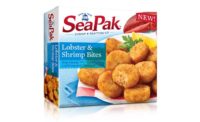Consumers are becoming increasingly concerned with product sourcing, health benefits, environmental impact and more. In the store, shoppers are searching for more value-added seafood products. To take a deep dive into consumer demand for value-added seafood, The National Provisioner consulted with Rasmus Soerensen, chief commercial officer for raw materials supplier American Seafoods. American Seafoods, the world's largest at-sea processor of wild Alaska pollock, sees great potential for this protein, noting wild Alaska pollock’s ability to meet a variety of consumer demands for value-added seafood attributes.
Soerensen noted the generational appeal of wild Alaska pollock. “Especially the younger seafood consumers are more concerned about eating healthy, about eating correctly, and also about leaving the least-possible impact on the planet in the food production, and wild Alaska pollock has a great profile there that’s being more appreciated now than ever,” Soerensen said. “For us as an industry it’s definitely something that we’re building upon.”
According to the Genuine Alaska Pollock Producers, Millenials are increasingly demanding seafood and wild Alaska pollock. In 2024, more consumers became aware of wild Alaska pollock, with 65% of Millennial consumers reporting a favorable opinion of the protein. Most of the Millennials surveyed prioritize sustainability, affordability and quality when considering their seafood purchases at retail. Wild Alaska pollock caters to each of these consumer demands, creating market opportunity for seafood producers.
Consumers seeking a sustainable protein source can look to wild Alaska pollock. The fish averages 1.4 kilograms of carbon dioxide equivalent for every kilogram of finished product. Additionally, wild Alaska pollock has a lower environmental impact than traditional meat products, as well as tofu.
"There's a lot of focus on the world's fresh water supply these days, and of course food manufacturing in general is using a lot of fresh water," Soerensen said. "We don't leave any impact on the fresh water supply in the world, because all the water we need in our production is made on-board our vessels from sea water."
While Wild Alaska pollock meets consumer demand for value-added seafood products, the challenge now is educating consumers on those attributes.
“The key opportunity for our industry in general is really messaging,” Soerensen said. “Historically, the seafood industry has not done a good job of really highlighting the features of our product.” These features include nutritional benefits, product value, consistent availability, and affordability. Consumers are increasingly valuing transparency in their food products. Educating consumers on the attributes of wild Alaska pollock not only satisfies consumer demand, but has potential to catapult category growth.
In addition to consumer education, Soerensen sees great opportunity for wild Alaska pollock within product innovation. Aside from the coasts, generally speaking, Americans eat more red meats than seafood products. By innovating within the seafood category, producers have an opportunity to draw in consumers who are traditionally meat eaters.







